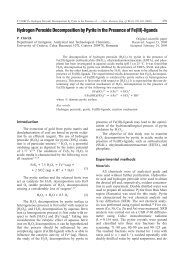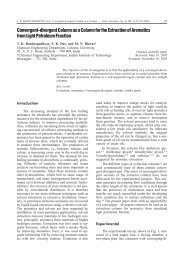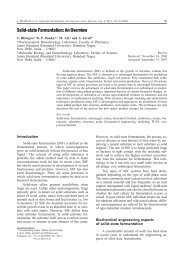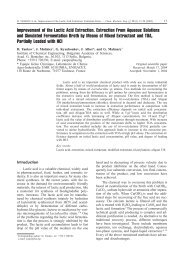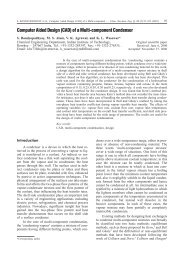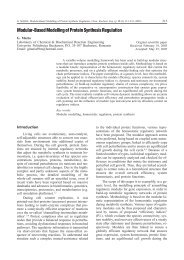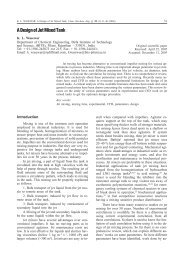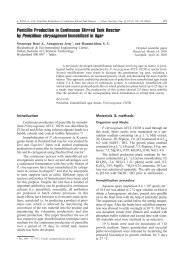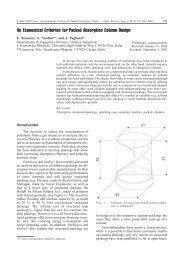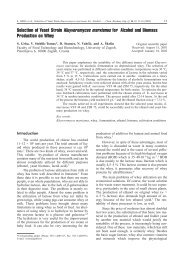Thymol Hydrogenation in Bench Scale Trickle Bed reactor - pierre
Thymol Hydrogenation in Bench Scale Trickle Bed reactor - pierre
Thymol Hydrogenation in Bench Scale Trickle Bed reactor - pierre
Create successful ePaper yourself
Turn your PDF publications into a flip-book with our unique Google optimized e-Paper software.
J. DUDAS et al., <strong>Thymol</strong> <strong>Hydrogenation</strong> <strong>in</strong> <strong>Bench</strong> <strong>Scale</strong> <strong>Trickle</strong> <strong>Bed</strong> Reactor, Chem. Biochem. Eng. Q. 19 (3) 255–262 (2005) 261<br />
temperatures well below 200 °C, nitrogen was replaced<br />
by hydrogen, and the feed pump (20 % wt.<br />
thymol feed) was restarted. The process was stabilised<br />
and the <strong>reactor</strong> bed temperature profile was<br />
measured (Figure 10). Comparison of experimental<br />
temperature profiles <strong>in</strong>dicated lower catalytic activity<br />
<strong>in</strong> the first 100 mm of catalyst. Overall temperature<br />
rise was similar to previously observed values,<br />
however the ‘hot spot’ shifted along the <strong>reactor</strong><br />
axis. This <strong>in</strong>dicated that thymol hydrogenation was<br />
completed <strong>in</strong> the first 200 mm of catalyst bed. This<br />
shift of the ‘hot spot’ <strong>in</strong>dicates that the orig<strong>in</strong>al activity<br />
of the catalyst at the beg<strong>in</strong>n<strong>in</strong>g of the bed was<br />
decreased by approximately 20 %.<br />
achieved). This fact <strong>in</strong>dicates that the process is<br />
controlled by reaction thermodynamics and no by<br />
its k<strong>in</strong>etics.<br />
Both, the process dynamics and parametric<br />
sensitivity are important system characteristics and<br />
they are critical for the system operation and<br />
scale-up. Experimental <strong>in</strong>vestigation of the system<br />
dynamics <strong>in</strong>dicated, that a steady state could be<br />
reached after approximately 3 h from a change <strong>in</strong><br />
process parameters. Stability tests of the catalyst activity<br />
have shown, that practically the same temperature<br />
profiles were observed after more than 500<br />
hours of operation. Activity of the catalyst was stable<br />
except for the catalyst overheat<strong>in</strong>g.<br />
Fig. 10 – Temperature profile for 20 % wt. thymol feed before<br />
and after temperature runaway<br />
Conclusion<br />
Experimental hydrogenation of thymol was<br />
performed <strong>in</strong> bench scale slurry and trickle bed <strong>reactor</strong>s.<br />
Investigation of thymol hydrogenation on powdered<br />
catalyst <strong>in</strong> slurry system, with a gas entra<strong>in</strong>ment<br />
impeller, has shown that the reaction is zero<br />
order with respect to thymol and the first order with<br />
respect to hydrogen. Based on experimental data<br />
the activation energy was estimated as 18.3 kJ<br />
mol –1 .<br />
Experiments <strong>in</strong> a trickle bed <strong>reactor</strong> at low liquid<br />
flow rate <strong>in</strong>dicated existence of <strong>in</strong>sufficiently<br />
wetted catalytic bed and so called ‘liquid channell<strong>in</strong>g’.<br />
The results obta<strong>in</strong>ed <strong>in</strong> a bench scale trickle<br />
bed <strong>reactor</strong> <strong>in</strong>dicated that the process is sensitive to<br />
feed temperature, liquid/gas flow rates, and liquid<br />
distribution <strong>in</strong> catalyst bed. Therefore, the process<br />
must be started carefully to avoid the occurrence of<br />
hot zones <strong>in</strong> the <strong>reactor</strong>. Experimental results and<br />
practical experience also showed the <strong>reactor</strong> system<br />
could be operated as an adiabatic system.<br />
It was found, that D/L menthol mass fraction<br />
depends ma<strong>in</strong>ly on the average temperature <strong>in</strong> the<br />
bed and it does not depend on the residence time<br />
(provided that complete conversion of thymol was<br />
List of symbols<br />
d p – particle diameter, mm<br />
D <strong>in</strong> – <strong>in</strong>side <strong>reactor</strong> diameter, mm<br />
L – <strong>reactor</strong> length, mm<br />
LHSV – liquid hour space velocity, h –1<br />
n – stirrer speed, m<strong>in</strong> –1<br />
p – pressure, MPa<br />
Q L – mass flow rate, kg h –1<br />
t – time, h<br />
T – temperature, °C<br />
w – mass concentration, %<br />
V – volume, L<br />
References<br />
1. Allakhverdiev, A. I., Kulkova, N. V., Murz<strong>in</strong>, D. Y., Catal.<br />
Letters 29 (1994) 57.<br />
2. Allakhverdiev, A. I., Kulkova, N. V., Murz<strong>in</strong>, D.Y., Ind.<br />
Eng. Chem. Res. 34 (1995) 1539 and 35 (1996) 989.<br />
3. Konuspaev, S. R., Zhanbekov, K. N., Bizhanov, Z. A.,<br />
Imankulov, T. S., Nurbaeva, R. K., K<strong>in</strong>et. Catal. 35 (1994)<br />
824.<br />
4. Konuspaev, S. R., Izv. Nats. Akad. Nauk Resp. Kaz. Ser.<br />
Khim. 5 (1994) 32.<br />
5. Besson, M., Bullivant, L., Nicolaus-de Champ, N.,<br />
Gallezot, P., Stud. Surf. Sci. Catal. 78 (1993) 115.<br />
6. Besson, M., Bullivant, L., Nicolaus-de Champ, N.,<br />
Gallezot, P., J. Catal. 140 (1993) 30.<br />
7. Allakhverdiev, A. I., Kulkova, N. V., Murz<strong>in</strong>, D. Y., K<strong>in</strong>et.<br />
Catal. 34 (1993) 934.<br />
8. Tungler, A., Mathe, T., Petro, J., Tarnai, T., Appl. Catal. 79<br />
(1991) 161.<br />
9. Konuspaev, S. R., Izv. Nats. Akad. Nauk Resp. Kaz., Ser.<br />
Khim. 6 (1994) 36.<br />
10. Bizhanov, Zh. A., Izv. M<strong>in</strong>ist. Nauki-Akad. Nauk Resp.<br />
Kaz. 4 (1998) 53.<br />
11. Konuspaev, S. R., Izv. Nats. Akad. Nauk Resp. Kaz. 5<br />
(1994) 37.<br />
12. Ravi, P., Divakar, S., J. Incl. Phenom. and Macrocyclic<br />
Chem. 39 (2001) 27.<br />
13. Kukula, P., Cerveny, L., Appl. Catal. – General A, 193<br />
(2000) 285.



